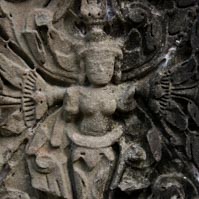
The German Ankorian Imagery Project
• G • A • I • P •
Bang Melea means "lotus pond". The name of this World Heritage Site aspirant is also transcribed Bung Melea, Beung Mealea or, more often, Beng Mealea. This jungletemple is located 77 km east of Siem Reap by road, and 50 km away from Angkor, as the crow flies.
Pocket guides and internet articles often describe Bang Melea as an insider tip, suggesting it would be not as touristed as the Angkor temples. But this has changed in recent years. Half-day excursions from Siem Reap to Bang Melea are quite popular, many bus groups visit Bang Melea, too. Nevertheless, it is worth a journey. And most visitors will never forget this jungle temple par excellence. Its trees are not as immense as those of Angkor's jungle-temple Ta Prohm, but there are many more trees covering the buildings in Bang Melea: The whole temple is a forest. Trees have grown out of temple towers, tendrils entangle walls and columns, and lichens cover stones. Bang Melea appears even more labyrinthic and mysterious than Ta Prohm since it has never been restored. Many stones lie in great heaps. Visitors have to use a wooden walkway which will lead to many parts of the temple, to its centre in particular.
Bang Melea was built at a strategically significant fork, where the the royal way to Preah Khan Kompong Svay (Prasat Bakan) branches of from the most important Angkorian royal way leading to Koh Ker, Preah Vihear and Dai Viet (in northern Vietnam). Furthermore, Bang Melea was situated at the head of a historical canal to Angkor. Bang Mealea is only 7 km away from the sandstone quarries at Phnom Kulen. This canal was used for the transport of sandstone blocks to Angkor.
Since the foundation date of the temple is not reported in inscription, it has to be dated by stylistic characteristics. Bang Melea is ascribed to the classical Angkor Wat period because of many similarities to the layout of Angkor Wat. This means, Bang Melea was built in the begin or in the middle of the 12th century. The ground plan of Beng Mealea is very similar to that of Angkor Wat. It may have served as a blueprint for the Angkor Wat or was a later copy of it. But there are significant differences between Angkor Wat and Bang Melea, the latter is a flat temple and had only one Prasat tower in the central inner enclosure instead of five.
Bang Melea's temple enclosure is 181 m long and 152 m wide. As in the case of Angkor Wat, the temple proper marked the centre of a whole town. The moat once enclosing the vast area of this temple town is now partly dried up. It measures 1025 m by 875m and is 45m wide. Immediately to the east was a large reservoir.
Altogether three almost concentric galleries (slightly shifted as in the case of Angkor Wat) enclose a central Prasat, which is collapsed now. Another counterpart to features of Angkor Wat are cruciform cloisters. The temple was built mostly of sandstone.
Bang Melea is famous for beautiful carvings. They show legends of Vishnu, Shiva and the Buddha as well. There are episodes from the Ramayana, e.g. the Agnipariksha, Sita's fire ordeal to prove her innocence. There is also a typical relief depicting the Churning of the Milk Ocean. Both subjects are connected to Avatars of Vishnu. Another remarkable pediment shows Agni, the god of fire, riding a rhinoceros.
Ernst Ando Sundermann
• G • A • I • P •
Copyright © 2021 khmer-heritage.de